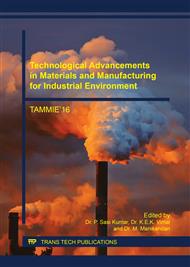p.233
p.239
p.245
p.254
p.261
p.272
p.283
p.290
p.294
Performance and Emission Analysis of a Ci Engine Fuelled with JOME-JOEE-Diesel Blends
Abstract:
In this study a high viscous liquid fuel, approximately 20 times more than that of diesel, produced from non- edible oil seed jatropha curcas which has been considered as an alternative fuel for the compression ignition engine is reduced through trans-esterification process. During this process, the raw jatropha curcas oil is preheated to 60°C and treated with methanol 20% by volume along with potassium hydroxide (KOH) by 0.568% of the oil weight as alkaline catalyst at 60°C reaction temp to produce Methyl Esters of Jatropha Oil (JOME). Similarly, the above method is followed to produce Ethyl Esters of Jatropha Oil (JOEE) with preheating at 70°C. In addition, 2% glycerol is added to the mixture to improve the reaction rate. The lower viscous fuel biodiesel (JOME and JOEE) produced by trans-esterifying of jatropha oil is blended with pure diesel 50% by volume. An experimental investigation have been carried out without altering the CI engine to examine the performance parameters in terms of brake thermal efficiency, total fuel consumption and brake specific fuel consumption for several engine load from 0 Kg to 8 Kg. The study also includes, separation of crude biodiesel from glycerol, washing of crude biodiesel, examination of calorific value using bomb calorimeter, viscosity measurement using redwood and brookfield viscometer, engine emission test and cost comparison for production of one litre of JOME and JOEE. It is inferred from the above study that the blends of JOME with diesel have closer performance to diesel when compared to the blend of JOEE with diesel. But, on comparison of their exhaust emission, the JOEE showed reasonable lower exhaust emission CO and NOx in spite of its higher calorific value when compared with JOME. The study also revealed that the biodiesel can be adopted as an alternative fuel for existing diesel engine without any modification.
Info:
Periodical:
Pages:
261-271
Citation:
Online since:
July 2017
Authors:
Price:
Сopyright:
© 2017 Trans Tech Publications Ltd. All Rights Reserved
Share:
Citation:


